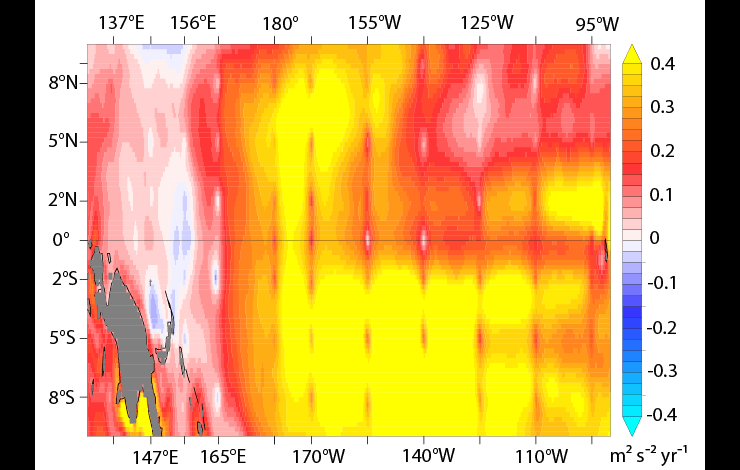Chiodi, A. M., J. P. Dunne, and D. E. Harrison ( 2019). Estimating air‐sea carbon flux uncertainty over the tropical Pacific: Importance of winds and wind analysis uncertainty. Global Biogeochemical Cycles, 33, 370– 390. doi: 10.1029/2018GB006047
About half of carbon emissions are currently absorbed by natural processes taking place on land and in the ocean. But not all regions of the Earth’s surface act as a sink for emitted CO2. The tropical Pacific Ocean stands out as a significant source of carbon to the atmosphere—even rivaling U.S. emissions. Understanding how this source has changed over recent decades, and how it might change in coming decades is important to understanding and predicting net carbon uptake by the oceans.
Changes in wind speeds over the tropical Pacific Ocean surface are one way in which the rate of exchange of carbon between the ocean and atmosphere (a phenomenon known as air-sea carbon flux) can change over time. Scientists may consult a variety of different types of wind information to try to determine if and how wind behavior has changed over recent decades. These sources include direct observations from moored buoys (the world’s densest array of open ocean buoys is deployed across the tropical Pacific), remote measurements from satellites and results from numerical weather models. When these sources are combined into one product, the result is often referred to as a wind analysis.
Recent examination of a popular wind analysis product has suggested that wind speed trends over the equatorial Pacific have caused a substantial 25-year increase in regional sea-to-air (upward) carbon flux. Our results reveal that the wind analysis used to support this claim is potentially quite misleading in that it agrees with the available moored buoy winds at the precise mooring locations (which appear as bullseyes in the accompanying figure), yet still exhibits a regional 25-year trend that is many times greater than that observed by the buoys. The implication of our finding is that the trend in air-sea carbon flux over the equatorial Pacific over the last 25 years is much smaller than previously thought.
To learn more, read the article at Global Biogeochemical Cycles (Wiley/AGU)



